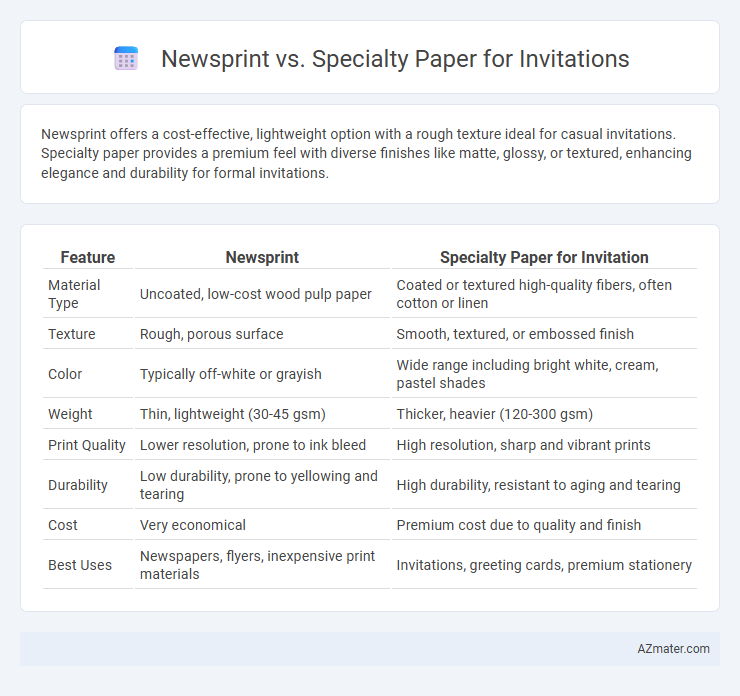Newsprint offers a cost-effective, lightweight option with a rough texture ideal for casual invitations. Specialty paper provides a premium feel with diverse finishes like matte, glossy, or textured, enhancing elegance and durability for formal invitations.
Table of Comparison
| Feature | Newsprint | Specialty Paper for Invitation |
|---|---|---|
| Material Type | Uncoated, low-cost wood pulp paper | Coated or textured high-quality fibers, often cotton or linen |
| Texture | Rough, porous surface | Smooth, textured, or embossed finish |
| Color | Typically off-white or grayish | Wide range including bright white, cream, pastel shades |
| Weight | Thin, lightweight (30-45 gsm) | Thicker, heavier (120-300 gsm) |
| Print Quality | Lower resolution, prone to ink bleed | High resolution, sharp and vibrant prints |
| Durability | Low durability, prone to yellowing and tearing | High durability, resistant to aging and tearing |
| Cost | Very economical | Premium cost due to quality and finish |
| Best Uses | Newspapers, flyers, inexpensive print materials | Invitations, greeting cards, premium stationery |
Introduction to Newsprint and Specialty Paper
Newsprint is a low-cost, lightweight paper primarily used for newspapers and mass printing, offering a smooth surface but limited durability and color vibrancy. Specialty paper, designed specifically for invitations, provides enhanced texture, thickness, and finish options such as linen, pearl, or recycled fibers, ensuring a premium, elegant presentation. Choosing between newsprint and specialty paper significantly affects the invitation's visual appeal, tactile feel, and overall impression on recipients.
Key Differences Between Newsprint and Specialty Paper
Newsprint is an economical, lightweight paper with low brightness and minimal durability, commonly used for newspapers and mass printing, whereas specialty paper is higher quality, thicker, and designed for specific uses like invitations, offering enhanced texture, color vibrancy, and durability. Specialty paper often includes finishes such as linen, pearl, or shimmer to provide a premium feel and superior print quality, making it ideal for formal invitations. The primary differences lie in weight, texture, print clarity, and finish options, with specialty paper delivering a refined aesthetic compared to the plain, functional nature of newsprint.
Cost Comparison: Economical vs. Premium Options
Newsprint offers a highly economical option for invitations, with production costs significantly lower than specialty papers, making it ideal for large-volume, budget-conscious events. Specialty papers, including textured, cotton, or vellum varieties, command premium prices due to higher material quality and distinct tactile appeal, enhancing the perceived value of each invitation. Choosing newsprint reduces expenditure without sacrificing readability, whereas specialty paper investments create a lasting impression through luxury and exclusivity.
Print Quality: Clarity and Color Vibrancy
Specialty paper offers superior print quality for invitations, delivering exceptional clarity and vibrant colors that enhance intricate designs and fine details. Newsprint, designed primarily for mass printing and low-cost distribution, lacks the smooth surface and brightness required for sharp images and rich color reproduction. Choosing specialty paper ensures invitations stand out with crisp text and vivid hues, creating a lasting impression through premium print clarity.
Texture and Feel: Tactile Experience for Invitations
Newsprint offers a lightweight, coarse texture ideal for informal invitations, providing a rustic and vintage tactile experience. Specialty paper, such as cotton or linen, delivers a smooth, luxurious feel with a premium weight that enhances the sense of elegance and exclusivity. The choice between newsprint and specialty paper significantly influences the invitation's perceived quality and emotional impact through texture and touch.
Durability and Longevity Considerations
Newsprint is generally less durable and prone to yellowing and tearing over time, making it unsuitable for invitations meant to be kept as keepsakes. Specialty papers, such as cotton or linen blends, offer enhanced longevity due to their acid-free composition and thicker fibers, ensuring invitations remain crisp and vibrant for years. Prioritizing specialty paper for invitations significantly improves durability and preserves the invitation's aesthetic quality over time.
Customization Options and Design Flexibility
Specialty paper offers extensive customization options and superior design flexibility for invitations, allowing for textures, finishes, and unique colors that enhance visual and tactile appeal. Newsprint, while cost-effective, provides limited customization and design capabilities, often resulting in simpler, less vibrant invitations. Selecting specialty paper ensures more creative freedom to produce distinctive, high-quality invitations tailored to specific themes and preferences.
Eco-Friendliness and Sustainability Factors
Newsprint, made primarily from recycled wood pulp, offers a more eco-friendly option due to its high recyclability and lower energy consumption during production. Specialty paper for invitations often uses virgin fibers and various coatings, reducing its biodegradability and increasing environmental impact. Choosing newsprint supports sustainability by minimizing resource use and waste, aligning with eco-conscious event planning.
Best Use Cases for Newsprint Invitations
Newsprint invitations excel in eco-friendly, budget-conscious events such as casual weddings, community gatherings, and art shows due to their affordability and recyclable nature. Their unique, vintage aesthetic enhances invitations for rustic or indie-themed occasions, making them a perfect choice for creative projects or mass mailings. While specialty paper offers premium texture for formal events, newsprint provides an environmentally sustainable option with distinctive charm.
Choosing the Right Paper for Your Event Invitations
Newsprint offers an economical option for mass-produced event invitations with its lightweight and easily printable surface, making it ideal for casual gatherings or budget-conscious events. Specialty paper, such as textured, cotton, or metallic finishes, enhances the tactile experience and visual appeal, elevating formal invitations for weddings, galas, and upscale celebrations. Selecting the right paper reflects the event's tone and ensures the invitation leaves a lasting impression on recipients.

Infographic: Newsprint vs Specialty Paper for Invitation
 azmater.com
azmater.com